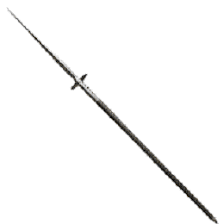Key Point: The awl pike weapon is a long polearm used extensively in medieval European wars.
Today we are exploring the weirdly named weapon ahlspiess or also known as awl pike. The weapon was popularly used during medieval times. You will see what made this polearm so effective and how it was used in battle. You will naturally also see what eventually leads to it disappearing from battle.
Now, before we move on it’s important we get clear on one thing. What exactly is an awl pike?
The awl pike is a type of polearm that was widely used in medieval Europe. This weapon consisted of a long wooden shaft, usually around 6 feet in length, topped with a pointed metal head. The head of the awl pike was characterized by a triangular or diamond-shaped cross-section, which gave it superior penetrating power compared to other polearms. It was primarily used as a thrusting weapon, allowing the user to deliver powerful and precise stabs to an opponent from a safe distance.
That was the key takeaway of the article. Now, let’s move on to exploring this topic in a little more detail. Starting with the origin.
Origin Of The Awl Pike

The origin of the awl pike can be traced back to the 14th century in Switzerland. There it was initially used by the Swiss Confederacy’s mercenary soldiers. The word “ahlspiess” itself means “awl pike” in German, which is a reference to the weapon’s long and narrow head.
The awl pike quickly gained popularity in other parts of Europe and became a favored weapon among both foot soldiers and knights. Due to its effectiveness in battle, the awl pike remained in use for several centuries until it ultimately vanished. You will see why a little later on.
Now, let’s explore where these Medieval soldiers put the awl pike to good use.
Battle Where It Was Used
One notable battle where the awl pike was used was the Battle of Morgarten in 1315. In this battle, the Swiss Confederacy faced off against the Habsburg dynasty. The Swiss army was primarily composed of peasants armed with a variety of weapons, including the awl pike.
During the battle, the Swiss were able to effectively use their awl pikes to pierce the heavily armored knights of the Habsburg army. The narrow and pointed heads of awl pikes allowed the Swiss to bypass the thick armor and inflict fatal wounds on their opponents. This battle ended in favor of the Swiss, partly due to their skilled use of polearms such as the awl pike.
Now, let’s check out the size of this weapon in a little more detail.
Size Of The Awl Pike
The awl pike measured around 6 feet in length. The head of the awl pike varied in length but was usually around 12 inches, with a triangular or diamond-shaped cross-section.
The long shaft of the awl pike allowed the user to keep a safe distance from their opponent, while the pointed head allowed for precise and powerful thrusts.
And now for the materials from which it was made.
What It Was Made From
The shaft of the awl pike or ahlspiess (whichever name you prefer) was made from wood, which was typically ash or oak due to its strength and durability. The wooden shaft was often reinforced with metal bands or rings to prevent it from splintering during battle. While the head of the ahlspiess was made from steel.
The metal head of the awl pike was often decorated with intricate designs and engravings, showcasing the skill of the craftsmen who made them. Some awl pikes were even adorned with precious metals and gems, making them highly prized possessions of the nobility.
And now, let’s see how it was used in battle.
Awl Pike Tactics
The awl pike was primarily used as a thrusting weapon in battle. Since it allowed the user to deliver powerful and precise stabs to their opponents from a safe distance. The pointed head of the pike allowed it to penetrate through armor, making it particularly effective against heavily armored opponents.
In battle, soldiers armed with awl pikes would typically form a phalanx formation, where they would stand in a tight formation with their shields overlapping to form a wall of defense. The long shaft of the pikes allowed them to reach over their shield wall and deliver powerful thrusts to the enemy.
Now, given it was an effective weapon for such a long time, let us see why it vanished from war altogether.
Why It Disappeared
The awl pikes remained in use for several centuries until the advent of firearms made them obsolete. The development of firearms, such as the musket and the arquebus, rendered the awl pikes and other polearms ineffective against heavily armored opponents.
Furthermore, the rise of professional standing armies in the 16th and 17th centuries led to a shift in tactics and warfare. Soldiers were no longer armed with a variety of weapons but instead were trained to use firearms exclusively.
As a result, the use of polearms, including the awl pikes, gradually declined until it disappeared from the battlefield altogether. A similar thing happened with this polearm the corseque.
In Conclusion
Thank you for taking the time to read this article. And I hope to see you at the next one. I suggest taking a peek at this article where I discuss the Viking polearm called atgeir. Check it out.
Or go here, to discover the Lucerne hammer, why it was used, and what made it powerful.
Take care!
Sources:
“European Arms and Armor” by Claude Blair
“The Medieval Soldier: 15th Century Campaign Life Recreated in Color Photographs” by Gerry Embleton and John Howe